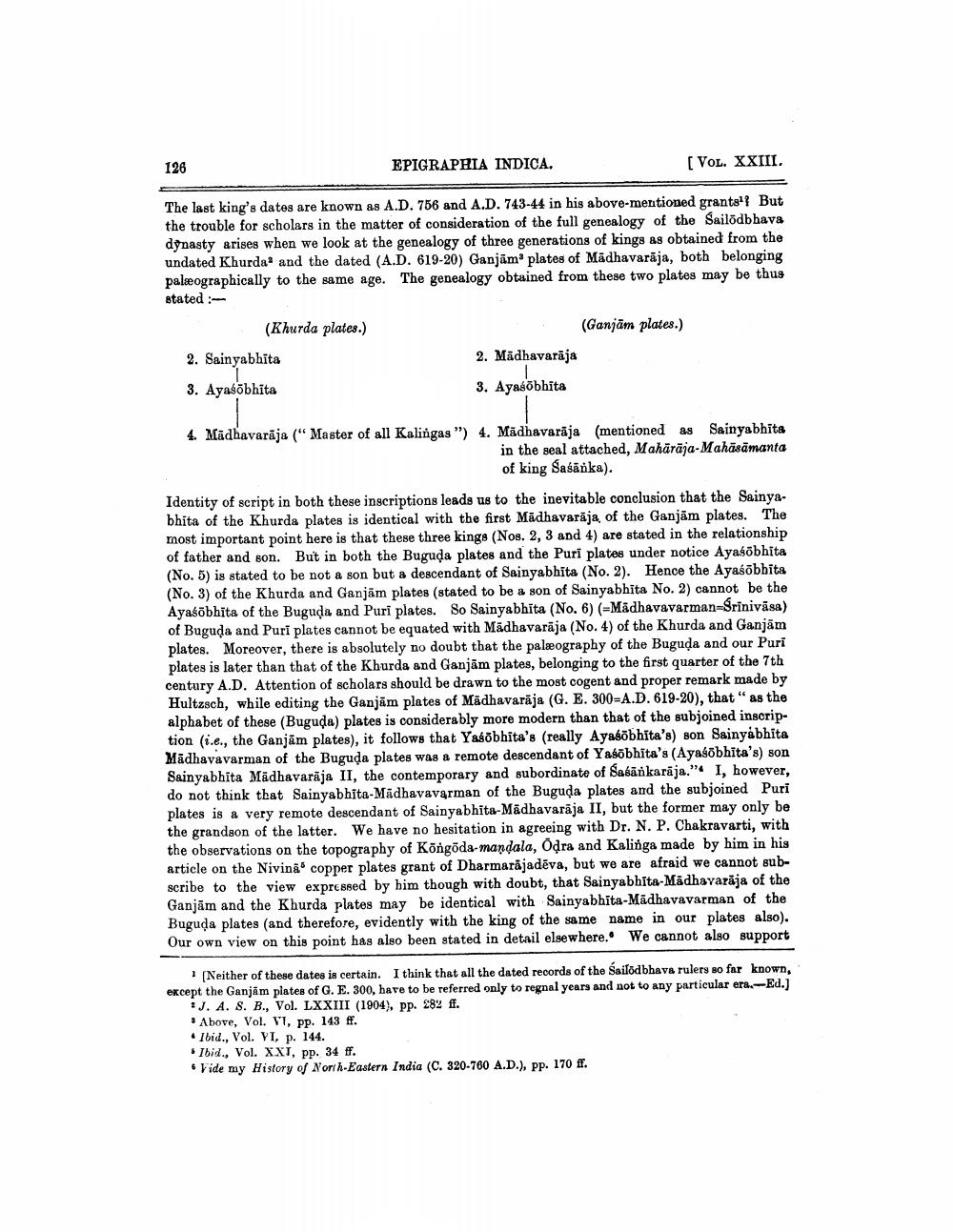________________
126
EPIGRAPHIA INDICA.
(VOL. XXIII.
The last king's dates are known as A.D. 756 and A.D. 743-44 in his above-mentioned grantsi? But the trouble for scholars in the matter of consideration of the full genealogy of the Sailodbhava dynasty arises when we look at the genealogy of three generations of kings as obtained from the undated Khurda and the dated (A.D. 619-20) Ganjām plates of Madhavarāja, both belonging paleographically to the same age. The genealogy obtained from these two plates may be thus stated :(Khurda plates.)
(Ganjām plates.) 2. Saingabhita
2. Madhavarāja 3. Ayaśābhīta
3. Ayasobhita
4. Madhavarāja ("Master of all Kalingas ") 4. Madhavarāja (mentioned as Sainyabhita
in the seal attached, Mahārāja-Mahāsāmanta of king Saśāřka).
Identity of script in both these inscriptions leads us to the inevitable conclusion that the Sainyabhita of the Khurda plates is identical with the first Madhavarāja, of the Ganjām plates. The most important point here is that these three kinge (Nos. 2, 3 and 4) are stated in the relationship of father and son. But in both the Buguda plates and the Puri plates under notice Ayasõbhita (No. 5) is stated to be not a son but a descendant of Sainyabhita (No. 2). Hence the Ayaśābhita (No. 3) of the Khurda and Ganjam plates (stated to be a son of Sainyabhīta No. 2) cannot be the Ayasőbhita of the Buguda and Puri plates. So Sainyabhita (No. 6) (-Madhavavarman-Srinivasa) of Buguda and Puri plates cannot be equated with Madhavarāja (No. 4) of the Khurda and Ganjām plates. Moreover, there is absolutely no doubt that the palæography of the Buguda and our Puri plates is later than that of the Khurda and Ganjām plates, belonging to the first quarter of the 7th century A.D. Attention of scholars should be drawn to the most cogent and proper remark made by Hultzsch, while editing the Ganjām plates of Mādhavarāja (G. E. 300-A.D. 619-20), that " as the alphabet of these (Buguda) plates is considerably more modern than that of the subjoined inscription (i.e., the Ganjām plates), it follows that Yaśõbhita's (really Ayasõbhita's) son Sainyábhita Mādhavavarman of the Buguda plates was a remote descendant of Yasõbhita's (Ayaśābhīta's) son Sainyabhita Madhavarāja II, the contemporary and subordinate of Saśārkarāja." I, however, do not think that Sainyabhita-Madhavavarman of the Buguda plates and the subjoined Puri plates is a very remote descendant of Sainyabhita-Madhavarāja II, but the former may only be the grandson of the latter. We have no hesitation in agreeing with Dr. N. P. Chakravarti, with the observations on the topography of Köngöda-mandala, Odra and Kalinga made by him in his article on the Nivina copper plates grant of Dharmarajadēva, but we are afraid we cannot subscribe to the view expressed by him though with doubt, that Sainyabhita-Madhavarāja of the Ganjām and the Khurda plates may be identical with Sainyabhita-Madhavavarman of the Buguda plates (and therefore, evidently with the king of the same name in our plates also). Our own view on this point has also been stated in detail elsewhere. We cannot also support
Neither of these dates is certain. I think that all the dated records of the Sailodbhava rulers so far known, except the Ganjam plates of G. E. 300, have to be referred only to regnal years and not to any particular era-Ed.)
* J. A. S. B., Vol. LXXIII (1904), pp. 282 ff. . Above, Vol. VI, pp. 143 ff. • Ibid., Vol. VI. p. 144.
Ibid., Vol. XXI, pp. 34 ff. • Vide my History of North-Eastern India (C. 320-760 A.D.), pp. 170 ff.




